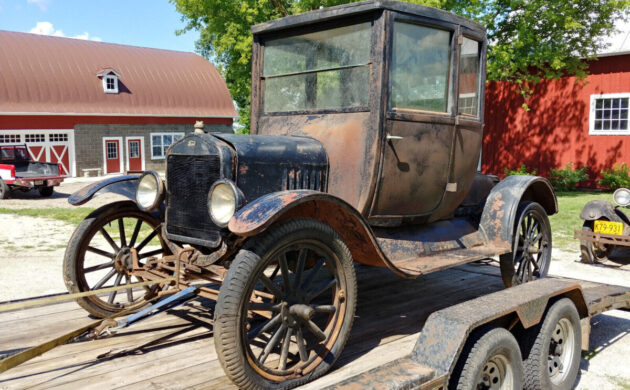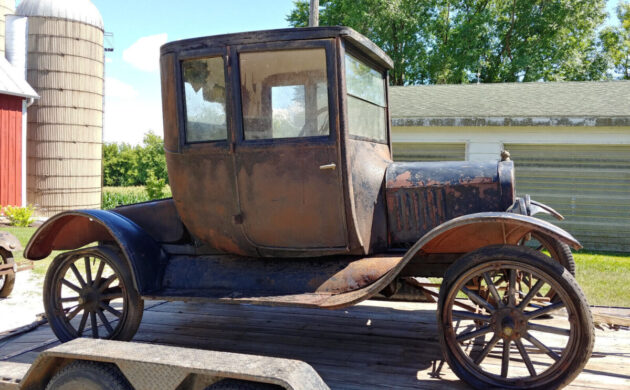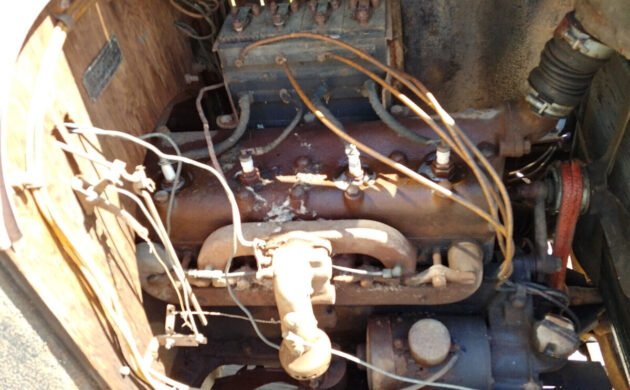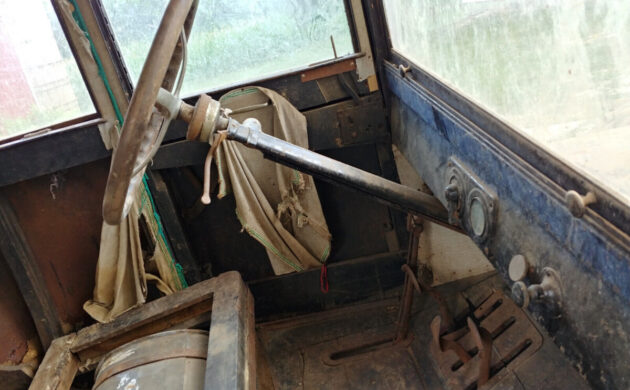Some classic cars make better restoration candidates than others. This is especially true for someone considering a first project. Dismantling and performing a first DIY build on something as complex as a Jaguar XJS may be stretching things. However, a vehicle like this 1923 Ford Model T might be perfect. It recently emerged after decades in hibernation and needs a new owner willing and able to return it to its former glory. The seller listed this promising project here on eBay in Fond du Lac, Wisconsin. The bidding has raced past the reserve and sits at $5,400.
Some enthusiasts are luckier than others, and the current owner of this old Ford is one such person. This is the second car they discovered in the Wisconsin barn because I recently featured this 1929 Ford Model A with a similar backstory. Both cars served their previous owner as daily drivers until being parked in 1959, and both have recently emerged after sixty-three years in hiding. This Model T is also quite solid, although some minor rust issues require attention. These have impacted the usual spots like the lower cowl, but with replacement steel easy to find, an owner with basic welding skills could consign the problems to a distant memory. The paint has seen better days, and I believe any restoration will involve stripping the panels to bare metal. The frame carries a coating of surface corrosion but is structurally sound. One area requiring the attention of a specialist is the spoked wheels. These can rot, and I’d rather spend the money having them reconditioned than have a suspect one fail while bowling along at 40mph! The glass looks good for its age, and any exterior plated components look suitable for restoration.
The heart of what made the Model T a success was its drivetrain combination. Ford’s 177ci flathead four-cylinder engine produced 20hp, and thanks to the company’s pioneering production techniques, it proved cheap to build and remarkably resilient. So great was the little flathead that it would eventually remain in production for many years beyond the life of the Model T and still competed successfully against more modern designs in some applications. The power from that little engine fed to the rear wheels via a two-speed planetary transmission that Henry chose because it was cheap to build and easily maintained. The setup did bring some complications with the vehicle controls, but the fact that more than fifteen million people bought a Model T suggests that adapting to the quirky driving style was not challenging. Under favorable conditions, a Model T could stretch its legs and gallop to 42mph, and while that may not seem fast today, it must have felt positively insane for those raised on a diet of horseback travel. This old Ford doesn’t run and hasn’t done since 1959. It is unclear whether the engine turns, but the buyer should factor an engine rebuild into their restoration budget. It is astounding to think that this engine is about to turn one hundred, and there are still mechanics who could rebuild them with their eyes closed.
The interior of a Model T continued Ford’s belief in focusing on function over form. Everything had to serve a purpose, and there was no room for luxury or automotive tinsel. Therefore, if air conditioning or power windows are on your Wish List, you’ve come to the wrong place! This interior is complete, although time and rodents have destroyed the upholstery and padding. The seat frame and springs are intact and look like they would restore nicely. That leaves the buyer with choices to make. Replacement upholstery is affordable and easy to install. However, the design simplicity means that some owners have successfully fashioned their own upholstery, reducing the restoration cost. That is an important consideration if you are on a limited budget where every penny counts. Otherwise, returning the interior to a factory-fresh state by purchasing a kit will lighten the owner’s wallet by around $1,000.
The Ford Model T makes an ideal first restoration candidate because, for all his character flaws, Henry Ford produced a car with elegantly simple engineering. That means that dismantling and reassembling a “T” is not challenging, and a restoration need not cost a fortune for a DIY enthusiast due to the availability and affordability of parts. It would have cost its original owner $345 in 1923, but it could command a value of $14,000 once the new owner puts down the tools. This car will celebrate its one-hundredth birthday next year, and I would like to think that it will do so by returning to active service. It seems only fitting after such an extended hibernation. Could you be the enthusiast who will make that dream a reality?





Would be lotsa fun after sorting out. Drive it
around the neighborhood…
I made sure I read Adams post carefully, so as not to repeat anything, but this was probably the most important vehicle of the early 20th century in the US, anyway. Even the seller makes no mention. This was called a “Doctors Coupe”, and countless lives were certainly saved by this little car. For the first time, doctors in rural settings could make emergency visits in much faster time than “ol Dobbin” and we owe a lot to this car. I’m sure it’s why the elderly owner saved it in the 1st place. Not sure what will happen to this stuff. Used to be, a museum would take it, for some display, it would have to be trailered anywhere today, and quite frankly, interest for this kind of vehicle is waning fast, I hope someone steps up, for sheer memories. Heck, one of our parents could have been saved by “Doc Adams” and this car.
Great write-up Adam, and Howard A, thank you for contributing what you did as that is a fact that I doubt most people know.
Problem is the the car is celebrating its 100th anniversary next year, just like the people interested in them. Few people know what to do with those 3 pedals and with museums going the way of Sears stores, potential buyers are fewer. Would be an easy restoration for the first timer & a neat car to putt around locally-just don’t make a wrong turn & enter the freeway.
Jay Leno made a point àbout the paint in one of his episodes about the pioneer cars.
The cars were painted with a brush and the high end ones were polished.
Cars for the masses were not and that is why they look dull
So, refinishing the car could be a DIY experience with a couple of coats of enamel and some wet sanding sessions between the coats.
Interest may be waning, but there are some young people who are still interested in old cars.
I’m Ninety and know how to use those three pedals. None of the three are the accelerator. That ought to scare the young whipper Snappers away.
I have a ’23 Dodge Brothers Commercial car I restored from the frame up.
It only took 10 years so I’m not certain this would be for me, but it would be fun to own.
It will also warn others about how hard it is to find 100-year-old parts and knowledge.
No mention of the late ’27 engine that is in it. No Howard A, they were never called a Doctor’s Coupe. Although many have given them that nickname over the years. Many also gave them the nickname “business coupe” witch did catch on a decade plus later when Dodge started selling a coupe called a business coupe. Also should be noted, Kelly Breen, that they were never painted with a paint brush. Not by Ford anyway. There are still advertising movie films that have been transferred to video that can be seen on YouTube of these cars being built in the River Rouge factory. The same type of videos exist for Dodge Brothers cars as well. Possibly others too.
You are right, I looked into it. I see where Leno was mistaken. However japanning or flow painting was not spray painting. The paint flowed on as a liquid and was smoothed with a tool that looks like a comb. The paint that ran off the car was collected and reused. Touch ups were done with a brush.
There is a full article in the model T forum.
But my point is the same. An accurate finish can be achieved without a spaybooth..